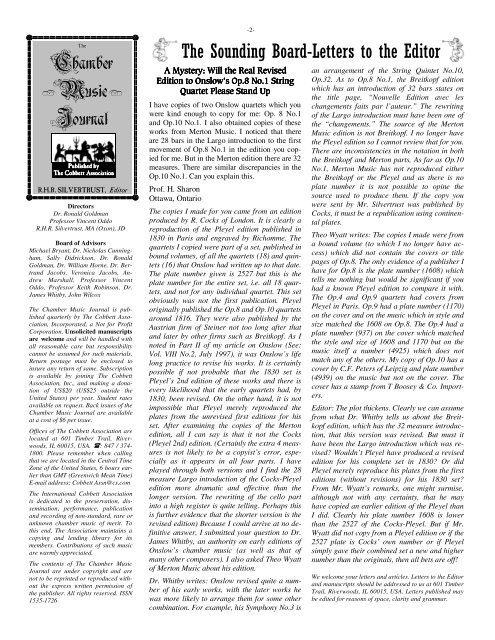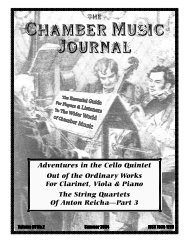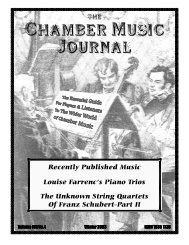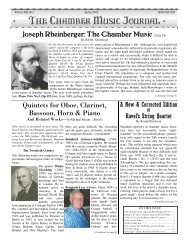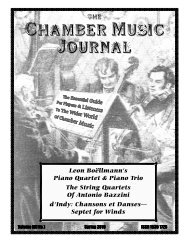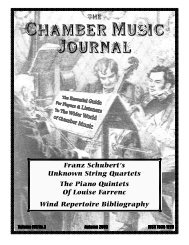Volume 12 No.4
Volume 12 No.4
Volume 12 No.4
You also want an ePaper? Increase the reach of your titles
YUMPU automatically turns print PDFs into web optimized ePapers that Google loves.
The<br />
Chamber<br />
Music <br />
Journal<br />
Published by<br />
The Cobbett Association<br />
R.H.R. SILVERTRUST, Editor<br />
Directors<br />
Dr. Ronald Goldman<br />
Professor Vincent Oddo<br />
R.H.R. Silvertrust, MA (Oxon), JD<br />
Board of Advisors<br />
Michael Bryant, Dr. Nicholas Cunningham,<br />
Sally Didrickson, Dr. Ronald<br />
Goldman, Dr. William Horne, Dr. Bertrand<br />
Jacobs, Veronica Jacobs, Andrew<br />
Marshall, Professor Vincent<br />
Oddo, Professor Keith Robinson, Dr.<br />
James Whitby, John Wilcox<br />
The Chamber Music Journal is published<br />
quarterly by The Cobbett Association,<br />
Incorporated, a Not for Profit<br />
Corporation. Unsolicited manuscripts<br />
are welcome and will be handled with<br />
all reasonable care but responsibility<br />
cannot be assumed for such materials.<br />
Return postage must be enclosed to<br />
insure any return of same. Subscription<br />
is available by joining The Cobbett<br />
Association, Inc., and making a donation<br />
of US$20 (US$25 outside the<br />
United States) per year. Student rates<br />
available on request. Back issues of the<br />
Chamber Music Journal are available<br />
at a cost of $6 per issue.<br />
Offices of The Cobbett Association are<br />
located at 601 Timber Trail, Riverwoods,<br />
IL 60015, USA. : 847 / 374-<br />
1800. Please remember when calling<br />
that we are located in the Central Time<br />
Zone of the United States, 6 hours earlier<br />
than GMT (Greenwich Mean Time)<br />
E-mail address: Cobbett Assn@cs.com<br />
The International Cobbett Association<br />
is dedicated to the preservation, dissemination,<br />
performance, publication<br />
and recording of non-standard, rare or<br />
unknown chamber music of merit. To<br />
this end, The Association maintains a<br />
copying and lending library for its<br />
members. Contributions of such music<br />
are warmly appreciated.<br />
The contents of The Chamber Music<br />
Journal are under copyright and are<br />
not to be reprinted or reproduced without<br />
the express written permission of<br />
the publisher. All rights reserved. ISSN<br />
1535-1726<br />
-2-<br />
The Sounding Board-Letters to the Editor<br />
A Mystery: Will the Real Revised<br />
Edition to Onslow’s Op.8 No.1 String<br />
Quartet Please Stand Up<br />
I have copies of two Onslow quartets which you<br />
were kind enough to copy for me: Op. 8 No.1<br />
and Op.10 No.1. I also obtained copies of these<br />
works from Merton Music. I noticed that there<br />
are 28 bars in the Largo introduction to the first<br />
movement of Op.8 No.1 in the edition you copied<br />
for me. But in the Merton edition there are 32<br />
measures. There are similar discrepancies in the<br />
Op.10 No.1. Can you explain this.<br />
Prof. H. Sharon<br />
Ottawa, Ontario<br />
The copies I made for you came from an edition<br />
produced by R. Cocks of London. It is clearly a<br />
reproduction of the Pleyel edition published in<br />
1830 in Paris and engraved by Richomme. The<br />
quartets I copied were part of a set, published in<br />
bound volumes, of all the quartets (18) and quintets<br />
(16) that Onslow had written up to that date.<br />
The plate number given is 2527 but this is the<br />
plate number for the entire set, i.e. all 18 quartets,<br />
and not for any individual quartet. This set<br />
obviously was not the first publication. Pleyel<br />
originally published the Op.8 and Op.10 quartets<br />
around 1816. They were also published by the<br />
Austrian firm of Steiner not too long after that<br />
and later by other firms such as Breitkopf. As I<br />
noted in Part II of my article on Onslow (See:<br />
Vol. VIII No.2, July 1997), it was Onslow’s life<br />
long practice to revise his works. It is certainly<br />
possible if not probable that the 1830 set is<br />
Pleyel’s 2nd edition of these works and there is<br />
every likelihood that the early quartets had, by<br />
1830, been revised. On the other hand, it is not<br />
impossible that Pleyel merely reproduced the<br />
plates from the unrevised first editions for his<br />
set. After examining the copies of the Merton<br />
edition, all I can say is that it not the Cocks<br />
(Pleyel 2nd) edition. (Certainly the extra 4 measures<br />
is not likely to be a copyist’s error, especially<br />
as it appears in all four parts. I have<br />
played through both versions and I find the 28<br />
measure Largo introduction of the Cocks-Pleyel<br />
edition more dramatic and effective than the<br />
longer version. The rewriting of the cello part<br />
into a high register is quite telling. Perhaps this<br />
is further evidence that the shorter version is the<br />
revised edition) Because I could arrive at no definitive<br />
answer, I submitted your question to Dr.<br />
James Whitby, an authority on early editions of<br />
Onslow’s chamber music (as well as that of<br />
many other composers). I also asked Theo Wyatt<br />
of Merton Music about his edition.<br />
Dr. Whitby writes: Onslow revised quite a number<br />
of his early works, with the later works he<br />
was more likely to arrange them for some other<br />
combination. For example, his Symphony No.3 is<br />
an arrangement of the String Quintet No.10,<br />
Op.32. As to Op.8 No.1, the Breitkopf edition<br />
which has an introduction of 32 bars states on<br />
the title page, “Nouvelle Edition avec les<br />
changements faits par l’auteur.” The rewriting<br />
of the Largo introduction must have been one of<br />
the “changements.” The source of the Merton<br />
Music edition is not Breitkopf. I no longer have<br />
the Pleyel edition so I cannot review that for you.<br />
There are inconsistencies in the notation in both<br />
the Breitkopf and Merton parts, As far as Op.10<br />
No.1, Merton Music has not reproduced either<br />
the Breitkopf or the Pleyel and as there is no<br />
plate number it is not possible to opine the<br />
source used to produce them. If the copy you<br />
were sent by Mr. Silvertrust was published by<br />
Cocks, it must be a republication using continental<br />
plates.<br />
Theo Wyatt writes: The copies I made were from<br />
a bound volume (to which I no longer have access)<br />
which did not contain the covers or title<br />
pages of Op.8. The only evidence of a publisher I<br />
have for Op.8 is the plate number (1608) which<br />
tells me nothing but would be significant if you<br />
had a known Pleyel edition to compare it with.<br />
The Op.4 and Op.9 quartets had covers from<br />
Pleyel in Paris. Op.9 had a plate number (1170)<br />
on the cover and on the music which in style and<br />
size matched the 1608 on Op.8. The Op.4 had a<br />
plate number (937) on the cover which matched<br />
the style and size of 1608 and 1170 but on the<br />
music itself a number (4925) which does not<br />
match any of the others. My copy of Op.10 has a<br />
cover by C.F. Peters of Leipzig and plate number<br />
(4939) on the music but not on the cover. The<br />
cover has a stamp from T Boosey & Co. Importers.<br />
Editor: The plot thickens. Clearly we can assume<br />
from what Dr. Whitby tells us about the Breitkopf<br />
edition, which has the 32 measure introduction,<br />
that this version was revised. But must it<br />
have been the Largo introduction which was revised<br />
Wouldn’t Pleyel have produced a revised<br />
edition for his complete set in 1830 Or did<br />
Pleyel merely reproduce his plates from the first<br />
editions (without revisions) for his 1830 set<br />
From Mr. Wyatt’s remarks, one might surmise,<br />
although not with any certainty, that he may<br />
have copied an earlier edition of the Pleyel than<br />
I did. Clearly his plate number 1608 is lower<br />
than the 2527 of the Cocks-Pleyel. But if Mr.<br />
Wyatt did not copy from a Pleyel edition or if the<br />
2527 plate is Cocks’ own number or if Pleyel<br />
simply gave their combined set a new and higher<br />
number than the originals, then all bets are off!<br />
We welcome your letters and articles. Letters to the Editor<br />
and manuscripts should be addressed to us at 601 Timber<br />
Trail, Riverwoods, IL 60015, USA. Letters published may<br />
be edited for reasons of space, clarity and grammar.


